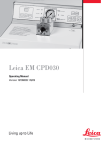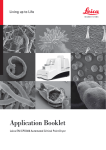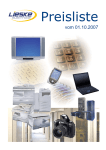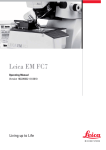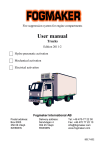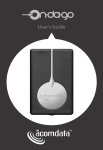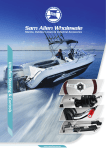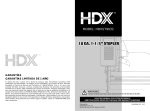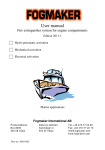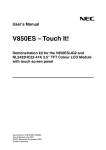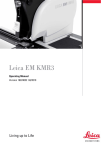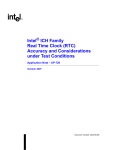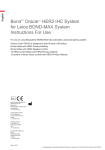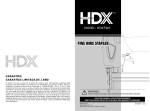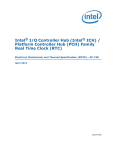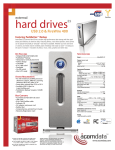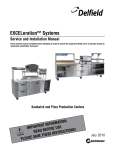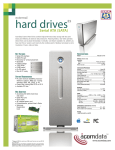Download Leica EM CPD300 Operating Manual
Transcript
Leica EM CPD300 Operating Manual 167180032 Version 06/2012 Important Note tinuously improve the technology and manufacturing techniques used to provide our ! " ! ! #$ " !! % & ## !%! !!& ' Issued by: Leica Mikrosysteme GmbH Hernalser Hauptstrasse 219 A-1170 Vienna Leica EM CPD300 2SHUDWLQJ0DQXDO Leica EM CPD300 Serial Number: Date of purchase: For the instrument serial number, please refer to the name type label on the back of the instrument! Please read this instruction manual carefully before operating the instrument. Foreword This technical documentation is intended to provide essential information about the proper operation and servicing of the Leica EM CPD300 critical point dryer. Service and operating staff must familiarize themselves with all components of the system before commissioning. Particular attention must be paid to the aspect of safety. Please retain this operating manual for future reference. Texts, schedules and tables may not be copied, reproduced, or divulged to third parties without the express consent of Leica Microsystems. In addition, all generally applicable legal and otherwise binding regulations for preventing accidents and protecting the environment must be observed by the user and communicated to all users. Page 1 Operating Manual Leica EM CPD300 06/12 Table of contents 1. Introduction ..............................................................................................................................3 2. Safety.........................................................................................................................................4 2.1 Safety concept of Leica Mikrosysteme GmbH....................................................................4 3. Installation and Warranty ........................................................................................................6 3.1 Installation............................................................................................................................6 3.2 Warranty ..............................................................................................................................8 4. Method.......................................................................................................................................9 4.1 Critical Point Drying Method................................................................................................9 5. Description and Specification ..............................................................................................11 5.1 Technical specifications ....................................................................................................11 6. Preparation of Specimens.....................................................................................................12 7. Automatic Operation of EM CPD300....................................................................................13 7.1 Screen descriptions...........................................................................................................13 7.2 Programming by example .................................................................................................17 7.3 Programming the EM CPD300 procedure ........................................................................26 7.4 Filling the Sample Chamber with exchange fluid..............................................................26 7.5 Inserting Specimen into Sample Container ......................................................................26 7.6 Preset of Cooling Temperature of the Sample Chamber .................................................27 7.6.1 CO2-Bottle Temperature / Pressure Function .............................................................27 7.7 Starting the EM CPD300 auto procedure .........................................................................28 7.8 Time and timer function.....................................................................................................28 8. Manual Operation of EM CPD300 .........................................................................................33 8.1 Screen descriptions...........................................................................................................33 8.2 Filling the chamber with exchange fluid............................................................................35 8.3 Inserting of Specimen into Sample Chamber ...................................................................35 8.4 Cooling of the Sample Chamber .......................................................................................35 8.5 Filling the CO2 into Sample Chamber ...............................................................................36 8.6 Mixing the two liquid media ...............................................................................................36 8.7 Exchange media mixture from Sample Chamber.............................................................36 8.8 Heating the Sample Chamber...........................................................................................37 8.9 Releasing gaseous CO2 from Sample Chamber ..............................................................37 9. Removing Dried Specimen ...................................................................................................37 10. Switching off the Unit ............................................................................................................37 11. Setting Panel...........................................................................................................................38 12. CO2-Bottle Temperature / Pressure Function .....................................................................39 13. Adjustments of Pressure Threshold for Bottle Empty Function......................................40 14. Software Update .....................................................................................................................43 15. Service Notes..........................................................................................................................45 15.1 Gas-Out filter maintenance ...............................................................................................45 15.2 General maintenance ........................................................................................................46 16. User Maintenance ..................................................................................................................47 16.1 Poral filter replacement .....................................................................................................47 16.2 Cleaning.............................................................................................................................49 17. Warnings and Troubleshooting............................................................................................49 Page 2 Operating Manual Leica EM CPD300 06/12 1. Introduction In order to ensure the safety of service technicians and operators, and to prevent any damage to the Leica EM CPD300 critical point dryer, it is essential to carefully read this manual before beginning any work with the system. This Operating Manual is intended to help the user understand the system more completely, to use it within the specified limits of its working capabilities, and to maintain in accordance with its physical parameters. This user manual includes important information regarding proper installation, operation, troubleshooting and repair. Following these instructions will help to prevent hazards, reduce repair and downtime costs, and prolong the system's service life. Symbols in this manual and their meaning: Danger! All paragraphs in the Technical Documentation that contain instructions regarding possible hazards are identified with this symbol. Non-observance these alerts may result in serious injury! Users of the instrument must comply with instructions at all times. Caution! This symbol alerts the user to important information which may endanger staff or result in damage to the system if it is ignored. Note! This symbol indicates further information relating to a previous explanation, which does not have a safety-critical function. However, it is important to follow this information to ensure that the system functions optimally. Page 3 Operating Manual Leica EM CPD300 06/12 2. Safety Warning! The EM CPD300 critical point dryer can be operated simply and safely, if the system is operated according to the operating manual. 2.1 Safety concept of Leica Mikrosysteme GmbH The use in accordance with regulations of the EM CPD300 critical point dryer consists of critical point drying of biological or industrial samples with minimal deformation of the specimens for subsequent SEM analysis. Any other application without written approval of the manufacturer can lead to damages and injuries of instrument and user. The manufacturer refuses to take any responsibility for damage caused thereby. The sample pressure chamber with a maximum working pressure of 150bar is secured with a Software and Hardware Cut Off function. Hardware controlled cut off Bursting membrane at 105bar at 20 °C (+/-10%) Software controlled cut off Pressure at 80bar and temperature at 45°C For safe operation it is absolutely necessary to set up and connect the device according to the instructions in Chapter 3. Page 4 Operating Manual Leica EM CPD300 06/12 General safety regulations Generally, the following safety regulations apply to the handling of the EM CPD300 critical point dryer: x Every user is responsible for her / his own health. x Only instructed users, authorized by the customer are allowed to work at or with the system. x For all interaction with the EM CPD300 the user must wear protective clothing prescribed in the respective environment. x It is strictly prohibited to alter or remove protective equipment or covers of any kind. x Every user must be trained in safe handling of the process gases and fluids that are utilized in the EM CPD300 unit. x After every repair the user (technician) must verify a flawless state of the system by a test run. x Leica can guarantee full operation of the system only if original spare parts according to the part lists are used. x Careful operation and preventive maintenance of the EM CPD300 reduces maintenance costs and assures reliable operation. x By means of frequent checks and prompt rectification of even small damages, considerable damage can often be avoided. x Observation of this operating manual and all notes installed on the system serves your own safety. Page 5 Operating Manual Leica EM CPD300 06/12 3. Installation and Warranty 3.1 Installation Required space for setting up the unit: width 340 mm, depth 583 mm. Operating room temperature: 20 – 35C° at 1bar (CO2 bottle limit) Relative humidity: 5 – 90% To allow adequate intake of cooling air required for the refrigeration unit and due to the inflexibility of the high pressure gas hose, a free space of 150 mm has to be provided on the backside of the instrument. Connection of CO2 Container It is absolutely necessary to use a pressurized gas container with a pipe (feed pipe), so that the medium (CO2) can reach the specimen pressure chamber in liquid form. In order to prevent accidents the CO2-pressurized gas container must be securely fastened in an upright position. Screw the high pressure gas hose onto the CO2 IN connection. Page 6 Operating Manual Leica EM CPD300 06/12 Connect the other end of the high pressure gas hose to the gas pressure container. The high pressure gas hose and seal are included in the accessory set of the unit. Electrical Connection Check assigned connecting voltage of the unit. Connect power cable to wall socket. Page 7 Operating Manual Leica EM CPD300 06/12 3.2 Warranty The EM CPD300 is covered by a WARRANTY in accordance with the conditions of sale. If functional errors should occur or if the components of the system sustain damage that is subject to warranty coverage during the warranty period, the manufacturer will repair or replace the faulty components following examination thereof. The manufacturer warrants for the system in its original configuration. Only original replacement parts may be used. The manufacturer accepts no liability for damage caused by use of other replacement parts. Caution! The environmental conditions that were agreed contractually and determined at the time of installation must be maintained. The manufacturer will not accept liability for damage caused by misuse of the system or its use for purposes other than the intended use, nor for damage caused by work on the system that is not described in this manual. Page 8 Operating Manual Leica EM CPD300 06/12 4. Method 4.1 Critical Point Drying Method Drying water-containing biological and material specimens in air or under vacuum can drastically alter their structures or even destroy them completely by tangential forces, caused by surface tension of the water (A). The surface tension is a quality of surfaces between a liquid and a gas and the tangential forces appears by boundary crossing from liquid to gaseous phase. Phase diagram P (bar) solid phase supercritical fluid liquid phase B Pc C Pt A gaseous phase T (°C) Pc = Critical Point Pt = Triple Point A = Air drying (phase boundary crossing) B and C = Critical point drying (no phase boundary crossing) Page 9 Operating Manual Leica EM CPD300 06/12 For biological and most micro-electro-mechanical (MEM) samples, critical point drying cannot be performed with water. Water’s critical point is at 374°C and 228.5bar. Every biological and MEM sample would be destroyed at this temperature and pressure. Therefore, the use of CO2 as transitional fluid is the first choice for critical point drying. It is liquid at room temperature at a comparative low pressure of 60bar. Its critical point is at 31°C and 73.8bar. Technically these temperature and pressure requirements of the CO2 can be implemented relatively easily. Hence, the water in the cell is replaced by an exchange medium like acetone or ethanol, which unlike water, are very soluble with liquid CO2. After the replacement of the water by an exchange fluid, this exchange medium is substituted with liquid CO2 through serial dilution steps. Thereafter by increasing the temperature, the pressure is increased proportionally and will transfer the CO2 through its critical point into a supercritical state (B). At constant temperature the controlled and carful depressurization converts the supercritical CO2 into its gaseous phase without crossing the phase boundary between liquid and gas (C). After coating, the dried sample can be analyzed in a scanning electron microscope (SEM). Comparison between air and critical point drying: Critical point dried sample (Water flea) Air dried sample (Water flea) Page 10 Operating Manual Leica EM CPD300 06/12 5. Description and Specification Introduction Biological specimens intended for investigation in a scanning electron microscope must be dried before being introduced into the microscope to allow the specimen to be imaged. If specimens with water content are dried, tangential forces, caused by surface tension of the water, destroys the structures of the specimen as mentioned in the previous chapter. Critical point drying with the EM CPD300 is the optimal method to prevent the damaging effects of the above mentioned forces by bringing the liquid to the gas phase without boundary crossing. 5.1 Technical specifications Dimensions: Weight: Empty weight 31 kg Sample chamber: Chamber dimension Volume Ø 60 mm x 62 mm 185 ml in empty chamber Pressure: Safety bursting membrane Software controlled cut off Max. operating pressure (Software controlled) Temperature: Heating range Software controlled cut off Heating time Slow Heating time Medium Heating time Fast Page 11 Operating Manual Leica EM CPD300 06/12 105bar at 20 °C 80bar 79bar adjustable >45°C 1°C/min. 2°C/min. 3°C/min. (+/-10%) 30°C to 45°C Cooling Cooling capacity Refrigerant Quantity Cooling range Cool down time 90 W at -5°C (2500 1/min) R134a 120 g adjustable 5°C to 25°C 2.0°C/min. Electrical Connection: Voltage Frequency Power consumption 100 V -230 V 50 / 60 Hz 170 VA Gas Connection: Gas inlet Gas outlet M 12 x 1.5 Ø 8 mm (inner diameter) Requirements Transitional fluid: Carbon Dioxide (chemical formula CO2) CO2 pressure bottle with feed pipe Exchange fluid: Acetone, Ethanol 6. Preparation of Specimens Wash in a physiological salt solution. Fix chemically with a suitable fixing agent. Wash out fixing agent with a suitable buffer solution. Dehydrate the chemically fixed specimen with acetone or ethanol. (Protocol examples are shown in the EM CPD300 Application booklet). Page 12 Operating Manual Leica EM CPD300 06/12 7. Automatic Operation of EM CPD300 7.1 Screen descriptions Initialization screen: Touch screen after initialization. Main Screen: 14 15 1 8 9 2 3 10 7 11 12 4 5 6 13 Dark gray buttons can be activated, light gray buttons are inactive! Page 13 Operating Manual Leica EM CPD300 06/12 1 Version of the EM CPD300. 2 Switch to program panel (see page 15). 3 Status display of fillers and holder in the sample chamber. Programmable under programs. 4 Status display temperature, pressure and time to finish the process (last point only with auto function). 5 Switch to settings (see page 37). 6 Light on/off 7 Status display of programmed process. In auto version buttons have no function. 8 Cooling temperature to keep CO2 fluid (can be changed under settings, page 37). 9 CO2 influx speed in pressure chamber. Programmable under programs. 10 Exchange speed (1-10) and status of finished exchange cycles. Programmable under programs. 11 Heating speed and heating temperature for critical point. Programmable under programs. 12 Status display gas out speed. Programmable under programs. 13 Process start. (after defining program). 14 Timer function (see page 27). 15 Program name of activated program (see page 15). Page 14 Operating Manual Leica EM CPD300 06/12 Programm Screen / Panel: 1 2 3 4 5 6 7 8 9 10 11 13 1 Activates key pad to enter program name. 2 Activated program is marked green. 3 Stirrer on / off with speed control. 4 Activation of auto version. If not highlighted manual version is active. Only selectable in automated version. 5 Sets speed of CO2 influx in pressure chamber. Three possibilities: slow, medium, fast. 6 Switch to filler and holder panel. Display of filler and holder status. 7 Sets delay time after influx of CO2 and before starting exchange process. 8 Sets exchange speed from 1-10. 9 Sets exchange cycles. 12 cycles means one chamber volume is completely exchanged. Minimum is 12 cycles. 10 Sets heating speed for critical point. Three possibilities: slow, medium, fast. 11 Sets gas out speed. Possibilities: slow, medium, fast. Slow speed can be decreased up to 20% of its normal speed. 12 Scrolls programs from 1-10. 13 Confirms activated program. Switch to main screen. Page 15 Operating Manual Leica EM CPD300 06/12 12 Filler/Holder Panel: 1 2 3 4 1 Filler and holder panel. 2 Status display of fillers and holders. 3 Sets specific holder and fillers. Combination of holders and fillers depends on their volumes. 4 Confirms filler and holder setting. Page 16 Operating Manual Leica EM CPD300 06/12 7.2 Programming by example Press Programs Press Program Name Type program name Page 17 Operating Manual Leica EM CPD300 06/12 Press OK to confirm program name Activate Stirrer Select stirrer speed Speed display will disappear after 4 sec. Page 18 Operating Manual Leica EM CPD300 06/12 Activated Stirrer Symbol becomes green Set CO2-IN speed Example: from slow to fast Press Fillers Program Filler/Holder combination Example: 1/2 Holder with 1/6 and 1/3 Filler Page 19 Operating Manual Leica EM CPD300 06/12 Press OK to confirm Filler/Holder settings Press Delay Set Delay Time Example: changed from 120s to 100s Page 20 Operating Manual Leica EM CPD300 06/12 Press OK to confirm Press Exchange Speed Set Exchange Speed Example: from 5 to 7 Page 21 Operating Manual Leica EM CPD300 06/12 Exchange Speed display will disappear after 4 sec. Press Exchange Cycles Set Exchange Cycles Example: from 16 to 12 Page 22 Operating Manual Leica EM CPD300 06/12 Press OK to confirm Set Heating Speed Example: from medium to fast Set Gas out Speed Example: from fast to slow Page 23 Operating Manual Leica EM CPD300 06/12 Select slow speed setting Example: from 100% to 75% slow Slow Gas out Speed display will disappear after 4 sec. Press OK to confirm Page 24 Operating Manual Leica EM CPD300 06/12 Press Start to activate program Test Page 25 Operating Manual Leica EM CPD300 06/12 7.3 Programming the EM CPD300 procedure Before placing the sample into the pressure chamber, program the EM CPD300 protocol. Switch to the program screen panel and follow the instructions under Program Panel (see page 17-25). Do not forget adjustment of the pressure threshold for the bottle empty function (see page 38-39). 7.4 Filling the Sample Chamber with exchange fluid Open the screw-on cover of the sample chamber by turning cover counter clockwise. Sample Container with quick release pin Before filling the sample chamber with exchange fluid, place the magnetic stirrer rod in bottom of the chamber. Fill exchange fluid into the sample chamber until the stirrer is covered. Then fill the sample container with exchange fluid to such a level that the sample holder and specimen will be completely submerged when inserted. 7.5 Inserting Specimen into Sample Container Open lid and transfer prepared specimen into a suitable sample holder. The sample holder must be filled with exchange fluid prior to transfer. Insert the sample holder into the sample container and fill sample container with exchange fluid until the sample holder is covered. Transfer the sample container into the sample chamber and check if sample holder is still covered with exchange fluid. Adjust container volume if required with fillers or additional sample holders. If sample holders with the volume of 33 – 50% are used, more sample holders or fillers can be added to the pressure chamber (up to 100%). Fully open the shut-off valve of the CO2 bottle. Page 26 Operating Manual Leica EM CPD300 06/12 7.6 Preset of Cooling Temperature of the Sample Chamber The pressure chamber cools up to the preset cooling temperature (15°C factory setting). The cooling temperature depends on the bottle temperature. Please see chapter “7.6.1. CO2-Bottle Temperature / Pressure Function” to select the appropriate cooling temperature. The cooling unit automatically keeps the temperature at the preset cooling temperature or below (see subchapter 7.6.1 below). 7.6.1 CO2-Bottle Temperature / Pressure Function For correct filling of the pressure chamber with CO2 a temperature difference of 4 °C minimum and a pressure difference of 5 bar is essential. Therefore, the pressure chamber has always to be minimum 4 °C cooler than the CO2-Bottle (see list bellow). You can find the adjustment of pressure chamber temperature under “settings” (see operating manual). The factory preset cooling temperature of the pressure chamber is 15°C. If the CO2 does not fill the chamber within a certain time, “Timeout CO2-IN” shows in the yellow box. If the poral filter is clean and the bottle is not empty the reason for the warning is the CO2 temperature bottle which is cooler than the chamber temperature. This means, due to the low temperature difference, the pressure of the CO2 in the bottle is not sufficient to fill-up the chamber. The temperature of the bottle can be estimated by measuring the bottle surface with a thermometer. The CO2 temperature is then about 2 °C cooler than the bottle surface. Decrease the chamber temperature according to the list below and fill again. The green marked values indicate the optimal working temperature and pressure range. Example: If the bottle surface temperature is 22 °C the estimated CO2 temperature is 20 °C, the cooling temperature of the chamber should be set to 15 °C. CO2-Temperature (°C) Recommended pressure chamber cooling temperature (°C) 14 9 15 10 16 11 18 13 20 15 22 17 24 19 25 20 26 21 28 23 Fully open the shut-off valve of the CO2 bottle. Page 27 Operating Manual Leica EM CPD300 06/12 7.7 Starting the EM CPD300 auto procedure After programming go back to the main menu and press start. 7.8 Time and timer function Press timer function (1). 1 The timer display pops up (2). 2 Page 28 Operating Manual Leica EM CPD300 06/12 Now you can change the local time (3)… 3 …or set the timer with the keypad (4). The timer function is activated if watch symbol is green (5). 4 5 Activated time fields become blue (6). 6 Page 29 Operating Manual Leica EM CPD300 06/12 Press OK and settings will be saved (7). 7 In the main screen the green watch symbol beside the local time indication shows that time is activated (8). By activating the timer no programming or other changes are possible. 8 9 To cancel timer settings press stop (9) … Page 30 Operating Manual Leica EM CPD300 06/12 …then pause (10)… 10 …and cancel (11). 11 Touch Process time field to check (in the main screen) the timer starting time (12)… 12 Page 31 Operating Manual Leica EM CPD300 06/12 …and touch starting time to check finishing time (13). 13 Page 32 Operating Manual Leica EM CPD300 06/12 8. Manual Operation of EM CPD300 8.1 Screen descriptions Initialization screen: Touch screen after initialization Main Screen before start: 7 1 8 9 2 10 11 3 4 5 Dark gray buttons can be activated, light gray buttons are inactive! Page 33 Operating Manual Leica EM CPD300 06/12 6 Main Screen after start: 11 5 1 Version of the EM CPD300. 2 Status display temperature, pressure. 3 Switch to Settings (see Page 37). 4 Light on/off. 5 Process Start / Stop. 6 Stirrer on / off. Is controlled in setting panel (see Page 37). 7 Cooling temperature to keep CO2 fluid. 8 Sets speed of CO2 influx in pressure chamber. Three possibilities: slow, medium, fast. To inactivate press again. 9 Sets exchange speed. Speed from 1-10. Shows opening status of the needle valve. To inactivate press again. 10 Sets heating speed for critical point. Three possibilities: slow, medium, fast. To inactivate press again. 11 Sets Gas out speed. Possibilities: slow, medium, fast. Slow speed can be decreased up to 20% of its normal speed. Adjustment under Settings / advanced slow Gas Out (see page 37). 12 Sets Time (see page 27). Page 34 Operating Manual Leica EM CPD300 06/12 8.2 Filling the chamber with exchange fluid Do not forget adjustment of the pressure threshold for the bottle empty function (See page 38-39)! Open the screw-on cover of the sample chamber by turning counter clockwise. Spacer with magnetic Stirrer Before filling the sample chamber with exchange fluid, place the magnetic stirrer rod together with the spacer into bottom of the sample chamber. Fill exchange fluid into the sample chamber until the stirrer and spacer is covered. Fill the sample chamber with exchange fluid to such a level that the specimen holder with specimen will be completely submerged when inserted. 8.3 Inserting of Specimen into Sample Chamber Open lid and transfer prepared specimen into a suitable sample holder. Quickly insert the sample holder with the specimen into the sample chamber filled with exchange fluid. Check if sample holder is still covered with exchange fluid. 8.4 Cooling of the Sample Chamber After tightly closing the screw-on cover of the sample pressure chamber, press Start. Press the cooling button and wait until pressure chamber cools up to the preset cooling temperature (15°C factory setting). The cooling temperature depends on the bottle temperature. Please see sub chapter “7.6.1 CO2-Bottle Temperature / Pressure Function” to select the appropriate cooling temperature. The cooling unit automatically keeps the temperature at the preset cooling temperature or below. Page 35 Operating Manual Leica EM CPD300 06/12 8.5 Filling the CO2 into Sample Chamber Wait until the sample chamber temperature has reached 15°C. Once this temperature is reached, completely open the shut-off valve of the CO2 bottle. Press CO2 In with the selected speed (slow, medium, or fast). The pressure display shows the pressure in the sample chamber (identical to the pressure in the CO2 bottle). Fill the sample chamber up to the upper edge of the front viewing glass with liquid CO2. Fill up to here with liquid C02 Press the CO2-In button again. CO2 goes off. The CO2 level in the sample chamber may rise slightly. 8.6 Mixing the two liquid media Press the STIRRER key. The magnetic stirrer is switched on. The magnetic stirrer should not be used if the specimens are very delicate. 8.7 Exchange media mixture from Sample Chamber Press the EXCHANGE button. Drain the media mixture from the sample chamber until the specimen is barely covered by the liquid. Press the EXCHANGE button again to close. This procedure of filling, mixing, and draining needs to be repeated several times (minimum 12 times) before heating to remove all the exchange fluid from the specimens. Multiple and, or larger specimens require more changes. Page 36 Operating Manual Leica EM CPD300 06/12 8.8 Heating the Sample Chamber Press the HEAT button and wait until sample chamber is heated up to 35°C. The cooling unit automatically keeps the temperature of the pressure chamber at 35q C. With the rising temperature the pressure in the sample chamber also increases as shown on the display. At the time the critical temperature and the critical pressure (31°C and 73,8 bar for CO2) have been passed, the liquid CO2 is transformed into the supercritical status. The system will stop at 35°C and 79 bar to be safe on the supercritical state. The change of the physical state can be observed through the front viewing glass. 8.9 Releasing gaseous CO2 from Sample Chamber After reaching the supercritical status, choose the GAS-OUT speed (slow, medium or fast) and press the GAS-OUT button. The temperature will be constant at 35°C only when the valve is opening to release the CO2, which will change the physical status from supercritical to gaseous due to the pressure decrease under constant temperature. 9. Removing Dried Specimen Close the shut-off valve of the CO2 bottle. Open the screw-on cover of specimen sample chamber. Remove specimen holder with dried specimen from sample chamber for further processing. Since the dried specimen is highly hygroscopic, it has to be coated as quickly as possible with a thin metal- or carbon film to protect it from atmospheric humidity. If this is not possible, it is recommended to keep the specimen in a desiccator until it is processed further. 10. Switching off the Unit Leave the sample chamber open. Leave the CO2 bottle closed. Switch off the main switch located on the unit. Page 37 Operating Manual Leica EM CPD300 06/12 11. Setting Panel Dark gray buttons can be activated, light gray buttons are inactive! 10 9 1 2 8 3 7 4 5 6 1 Sets cooling temperature to keep CO2 fluid. (Not recommended to change). 2 Sets heating temperature to reach the critical point. (Not recommended to change). 3 Sets stirrer speed, (recommended adjusting to sample sensitivity). 4 Press Main to switch to main screen. 5 Press update for software updates (USB). 6 Service Panel just for Service technician (see Service Manual). 7 Adjustment of Gas-out speed at slow. Function under settings only in the manual version accessible. In the auto version the advanced slow Gas-out speed adjustment is accessible under program display (see page 15). 8 System counts every complete run for maintenance advices (see page 40). 9 Volume change. 10 Physical unit change. Page 38 Operating Manual Leica EM CPD300 06/12 12. CO2-Bottle Temperature / Pressure Function For correct filling of the pressure chamber with CO2 a temperature difference of 4 °C minimum and a pressure difference of 5 bar is essential. Therefore, the pressure chamber has always to be minimum 4 °C cooler than the CO2-Bottle (see list bellow). You can find the adjustment of pressure chamber temperature under “settings” (see operating manual). The factory preset cooling temperature of the pressure chamber is 15°C. If the CO2 does not fill the chamber within a certain time, “Timeout CO2-IN” shows in the yellow box. If the poral filter is clean and the bottle is not empty the reason for the warning is the CO2 temperature bottle which is cooler than the chamber temperature. This means, due to the low temperature difference, the pressure of the CO2 in the bottle is not sufficient to fill-up the chamber. The temperature of the bottle can be estimated by measuring the bottle surface with a thermometer. The CO2 temperature is then about 2 °C cooler than the bottle surface. Decrease the chamber temperature according to the list below and fill again. The green marked values indicate the optimal working temperature and pressure range. Example: If the bottle surface temperature is 22 °C the estimated CO2 temperature is 20 °C, the cooling temperature of the chamber should be set to 15 °C. CO2-Temperature (°C) Recommended pressure chamber cooling temperature (°C) 14 9 15 10 16 11 18 13 20 15 22 17 24 19 25 20 26 21 28 23 Page 39 Operating Manual Leica EM CPD300 06/12 13. Adjustments of Pressure Threshold for Bottle Empty Function The bottle empty function was developed to protect the samples if the CO2 bottle becomes empty during a run. When the warning occurs, all valves will be closed so that the pressure chamber is sealed and the empty bottle can be exchanged with reduced possibility of sample damage. The threshold for this function has to be adapted to the CO2 temperature. See list below. Green marked values indicate optimal working temperature and pressure range. CO2-Temperature (°C) Recommended threshold for pressure (bar) Pressure of full CO2Bottle (bar) 14 47 50 15 48 51 16 49 52 18 52 55 20 54 57 22 57 60 24 60 63 25 61 64 26 63 66 28 66 69 Page 40 Operating Manual Leica EM CPD300 06/12 Adjustments of Pressure Threshold: Press Settings, select Service, enter password (see operating manual) and press ok. In the advanced settings screen touch the “CO2 bottle empty pressure threshold” area. Page 41 Operating Manual Leica EM CPD300 06/12 Change CO2 bottle empty pressure threshold value according to the list on page 45. The CO2 temperature can be estimated by measuring bottle surface with thermometer. CO2 temperature is then about 1-2 °C cooler then the bottle surface. Press „ Back“ to confirm. Page 42 Operating Manual Leica EM CPD300 06/12 14. Software Update Insert USB stick with EM CPD300 software. Software modules will be automatically recognized by the system. Choose the module you want to update. Page 43 Operating Manual Leica EM CPD300 06/12 After software update, press back. Page 44 Operating Manual Leica EM CPD300 06/12 15. Service Notes 15.1 Gas-Out filter maintenance After 100 runs are performed, the following note appears: Under Chapter 14 (Maintenance) the poral filter replacement is described. Page 45 Operating Manual Leica EM CPD300 06/12 15.2 General maintenance After 500 runs a general maintenance is recommended! Page 46 Operating Manual Leica EM CPD300 06/12 16. User Maintenance Before starting the maintenance the pressure has to be released in the sample chamber, the CO2-bottle has to be closed, and the CO2 connection to the EM CPD300 has to be disconnected. 16.1 Poral filter replacement Remove front cover Use a 17 size wrench to open the nut in the valve block. Remove nut, which includes porous filter, from the valve block. Page 47 Operating Manual Leica EM CPD300 06/12 Remove poral filter with spring from the nut. Remove spring from poral filter. Exchange poral filter with the correct size (Poral filter (0.5 μm) for CO2 Inlet (left) and Poral filter (75 - 100 μm) for CO2 Outlet (right). Reassemble poral filter in to the nut and screw nut in valve block. Page 48 Operating Manual Leica EM CPD300 06/12 16.2 Cleaning All surfaces can be cleaned with aqueous reagents or 60% ethanol and a clean cloth. 17. Warnings and Troubleshooting The list below summarizes Warnings (W...). Regarding most of the displayed information, just follow the instructions; in the case of error messages, contacting your local Leica Service is required. Code Warning Cause Action 10E11 Com connection default 10E12 Lid open Process can not start if lid open Close lid 10E13 Separator missing Process can not start or continue if separator is missing Insert separator 10E14 Separator full Process can not start or continue if separator is full Empty separator 10E16 Heatup error Pressure too low Check CO2-bottle 10E17 Timeout CO2-IN CO2-bottle empty or poral inlet filter is clogged Check CO2-bottle or exchange poral inlet filter 100E3 Pressure sensor failure 100E4 Pressure fault 100E5 Temperature sensor failure Call Leica service Call Leica service Poral outlet filter blocked Page 49 Operating Manual Leica EM CPD300 06/12 Exchange poral outlet filter Call Leica service EC Declaration EC Declaration of Conformity EG Konformitäts-Erklärung Déclaration CE de Conformité We/Wir/Nous Leica Mikrosysteme GmbH Hernalser Hauptstrasse 219 A-1170 Wien, Austria declare in exclusive responsibility that the product erklären in alleiniger Verantwortung, dass das Produkt déclarons sous notre seule responsabilité que le produit Model EM CPD300 Modell EM CPD300 modèle EM CPD300 Type/Typenbezeichnung/type EM CPD300 to which this declaration relates is in conformity with the following standards: auf das sich diese Erklärung bezieht, mit den folgenden Normen übereinstimmt: auquel se réfère cette déclaration est conforme aux normes : EN 61010-1 EN 61326-1 following the provisions of directive gemäss den Bestimmungen der Richtlinie conformément aux dispositions de directive 2004/108/EC 2006/95/EC Wien, 17th June 2011 Leica Microsysteme GmbH Hernalser Hauptstrasse 219 A-1170 Wien (Electromagnetic compatibility) (Elektromagnetische Verträglichkeit) (Low Voltage Equipment) (Niederspannungsrichtlinie) Dr. Reinhard Lihl Entwicklungsleiter R & D Manager Chef du service développement Tel. +43 1 48899 Fax +43 1 48899-350 www.leica-microsystems.com www.leica-microsystems.com The statement by Ernst Leitz in 1907, “With the User, For the User,” describes the fruitful collaboration with end users and driving force of innovation at Leica Microsystems. We have developed five brand values to live up to this tradition: Pioneering, High-end Quality, Team Spirit, Dedication to Science, and Continuous Improvement. For us, living up to these values means: Living up to Life. Leica Microsystems operates globally in four divisions, where we rank with the market leaders. LIFE SCIENCE DIVISION The Leica Microsystems Life Science Division supports the imaging needs of the scientific community with advanced innovation and technical expertise for the visualization, measurement, and analysis of microstructures. Our strong focus on understanding scientific applications puts Leica Microsystems’ customers at the leading edge of science. INDUSTRY DIVISION The Leica Microsystems Industry Division’s focus is to support customers’ pursuit of the highest quality end result. Leica Microsystems provide the best and most innovative imaging systems to see, measure, and analyze the microstructures in routine and research industrial applications, materials science, quality control, forensic science investigation, and educational applications. BIOSYSTEMS DIVISION The Leica Microsystems Biosystems Division brings histopathology labs and researchers the highest-quality, most comprehensive product range. From patient to pathologist, the range includes the ideal product for each histology step and high-productivity workflow solutions for the entire lab. With complete histology systems featuring innovative automation and Novocastra™ reagents, Leica Microsystems creates better patient care through rapid turnaround, diagnostic confidence, and close customer collaboration. MEDICAL DIVISION The Leica Microsystems Medical Division’s focus is to partner with and support surgeons and their care of patients with the highest-quality, most innovative surgical microscope technology today and into the future. Leica Microsystems – an international company with a strong network of worldwide customer services: Active worldwide Tel. Fax 2 8870 3500 2 9878 1055 Australia ∙ North Ryde +61 Austria ∙ Vienna +43 1 486 80 50 0 1 486 80 50 30 Belgium ∙ Groot Bijgaarden +32 2 790 98 50 2 790 98 68 800 248 0123 847 405 0164 Canada ∙ Concord/Ontario +1 Denmark ∙ Ballerup +45 4454 0101 4454 0111 France ∙ Nanterre Cedex +33 811 000 664 1 56 05 23 23 Germany ∙ Wetzlar +49 64 41 29 40 00 64 41 29 41 55 Italy ∙ Milan +39 02 574 861 02 574 03392 Japan ∙ Tokyo +81 3 5421 2800 3 5421 2896 Korea ∙ Seoul +82 2 514 65 43 2 514 65 48 Netherlands ∙ Rijswijk +31 70 4132 100 70 4132 109 +852 2564 6699 2564 4163 People’s Rep. of China ∙ Hong Kong ∙ Shanghai Portugal ∙ Lisbon +86 +351 21 6387 6606 21 6387 6698 21 388 9112 21 385 4668 Singapore +65 6779 7823 6773 0628 Spain ∙ Barcelona +34 93 494 95 30 93 494 95 32 Sweden ∙ Kista +46 8 625 45 45 8 625 45 10 Switzerland ∙ Heerbrugg +41 71 726 34 34 71 726 34 44 United Kingdom ∙ Milton Keynes +44 800 298 2344 1908 246312 +1 800 248 0123 847 405 0164 USA ∙ Buffalo Grove/lllinois Leica EM CPD300 Operating Manual, English. Order no.:167180032, Version 06/2012. Copyright © by Leica Mikrosysteme GmbH, Vienna, Austria, 2012. LEICA and the Leica Logo are registered trademarks of Leica Microsystems IR GmbH.
























































